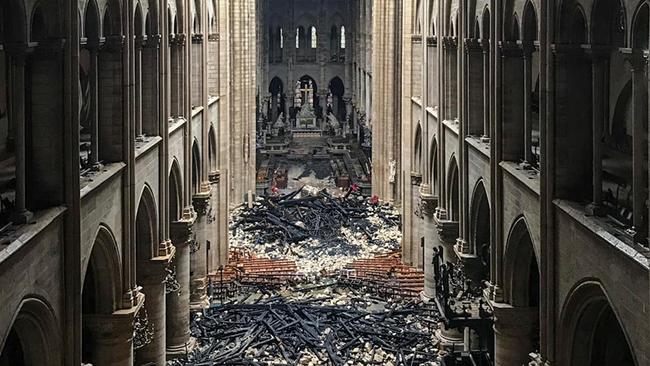66 minutes to save Notre Dame’s heavenly treasures from a fiery hell
As flames snarled across Notre Dame, firefighters, council workers and priests passed treasures to safety. They had 66 minutes.

Fuelled by a lattice of centuries-old timbers, the fire moved hungrily across Notre Dame’s rooftop toward the cathedral’s iconic spire. It belched yellow smoke, spitting out gritty particles of wood, stone, lead and iron, and wanted more. Far below, their vision obscured by fumes and tears, firefighters, priests and municipal workers passed treasures hand to hand, hoping the speed of desperation could outrun the flames.
They had 66 minutes.
The first alarm sounded at 6.20pm on Monday (2.20am Tuesday AEST), silencing the priest and a few hundred worshippers and tourists inside.
“Everyone was immobilised by shock for maybe a minute,” said Johann Vexo, who was in the organ loft for Monday mass. Shock, but no panic. The rear doors opened and within a few minutes, the cathedral was empty, he told Ouest-France newspaper.
For 23 minutes, it seemed like a false alarm. Then at 6.43pm a second smoke detector went off and the fire showed its face, flickering in the wooden timbers and visible to anyone who happened to look north from Paris’s Left Bank.
The first firetrucks lumbered through peak-hour traffic, blasting their two-tone sirens at full volume to reach the island that is the historic and geographic heart of Paris. For that first half-hour, it looked like the fire couldn’t possibly leave more than a small age mark on the nearly 900-year-old building — more akin to the inevitable wear on stone’s rough edges than the fury of the French Revolution that left it in ruins for decades.
Bridge after bridge along the Seine filled with sombre onlookers, all facing the cathedral built for the ages. They dotted the stone walkways that line the river. They wept as flames overtook the rooftop spire. Below it, nestled deep in the cathedral, was the treasure chest, keeper of Notre Dame’s most sacred relics.
Firefighters cracked the chest open, pulling out the Crown of Thorns revered as the one worn by Jesus Christ at his crucifixion. Made of rushes wrapped into a wreath and tied with gold filament, it had been kept under glass since 1896. The tunic of St Louis, believed to have belonged to King Louis IX, came out of the chest along with fragments of the cross and a nail, said Patrick Chauvet, rector of Notre Dame Cathedral.
The relics were safe. Then came the artwork. “We had to get them, in the smoke, as debris was falling, to protect them,” Paris fire brigade commander Jean-Claude Gallet told BFM television.
At 7.49pm, the 19th-century spire that was the architectural masterpiece of Eugene Viollet-le-Duc and his post-revolutionary restoration broke apart and fell through the nave. The bronze weathercock tumbled, taking with it three relics sealed inside in 1935.
It had been 66 minutes since the first flames were spotted.
The sky above the cathedral flamed orange, and the fire lurched toward Notre Dame’s iconic towers, then slipped inside.
Gallet had faced a critical choice as he arrived at Notre Dame. Should he tell the 400 or so firefighters involved in the operation to focus on putting out the blaze in the roof? Or should they try to prevent the flames from reaching the rest of the 855-year-old cathedral? A wind was blowing, the fire was spreading and time was short, but he had precious information from images taken by a Chinese-made police drone flying overhead.
A look at the pictures made up Gallet’s mind: the roof was lost and the real battle would be to save the monument from collapse. Firefighters using 18 hoses, some on hydraulic platforms around the building, sprayed water pumped from the Seine throughout the evening. But the decisive battle was inside the belfry at the top of the northern tower at the front of the cathedral. Gallet was afraid that if the belfries were toppled by the flames, they would crash down, bells and all, taking the tower with them. The collapse of a tower could, in turn, cause the collapse of the entire edifice. As darkness fell, 20 firefighters climbed inside the two towers “at great risk to their lives, to attack the fire from the inside and save the building”, said Deputy Interior Minister Laurent Nunez.
But when the spire fell, Gallet decided it was too dangerous for them to remain and ordered their retreat. They were replaced by Colossus, a 500kg firefighting robot that can take pictures, measure the temperature, detect dangerous gases, assess risk of an explosion and spray 2500 litres of water a minute until its battery runs down after five hours. Fire brigade spokesman Gabriel Plus said Colossus had proved its worth, reducing the temperature in the nave while preserving the lives of firefighters.
The 20 firefighters struggled on in the towers. Red-hot embers floated down from the glowing hole where the spire once stood, settling on the blackened marble floor and the pile of debris that was all that was left of the spire.
At 11.23pm, Gallet said the rest of the structure, including the cathedral’s twin bell towers, had been saved. It had been within 30 minutes of collapse. It took 10 more hours for the last flames to be put out. The spire’s bronze rooster, long a symbol of France, was found on Tuesday, deformed by the heat but recognisable nonetheless.
The overwhelming sense in Paris was that it could have been much worse — and indeed would have been if anyone had followed Donald Trump’s advice to drop water on the fire from aircraft. “It would have been like playing bowls with the cathedral,” a rescue service spokesman said. “Everything would have collapsed.”
AP, The Times



To join the conversation, please log in. Don't have an account? Register
Join the conversation, you are commenting as Logout